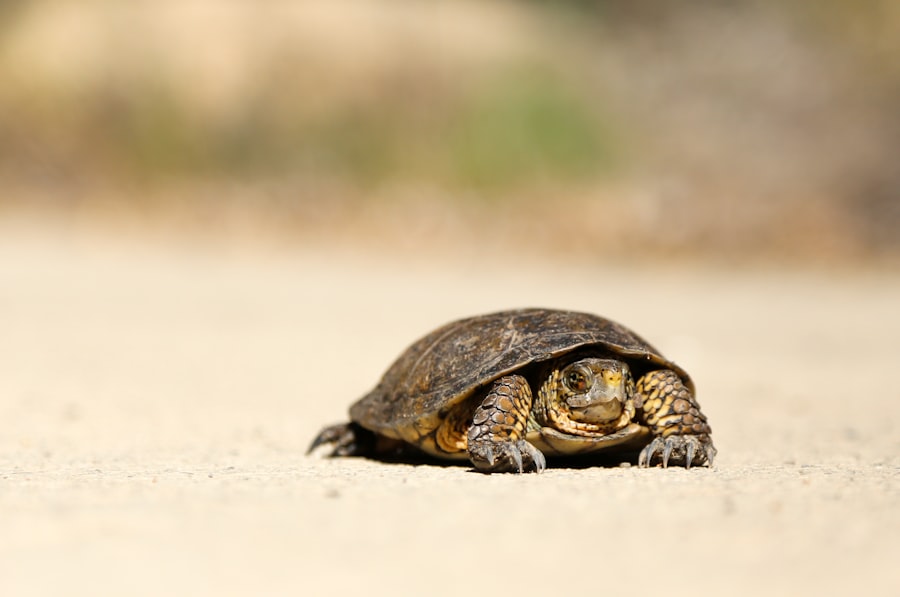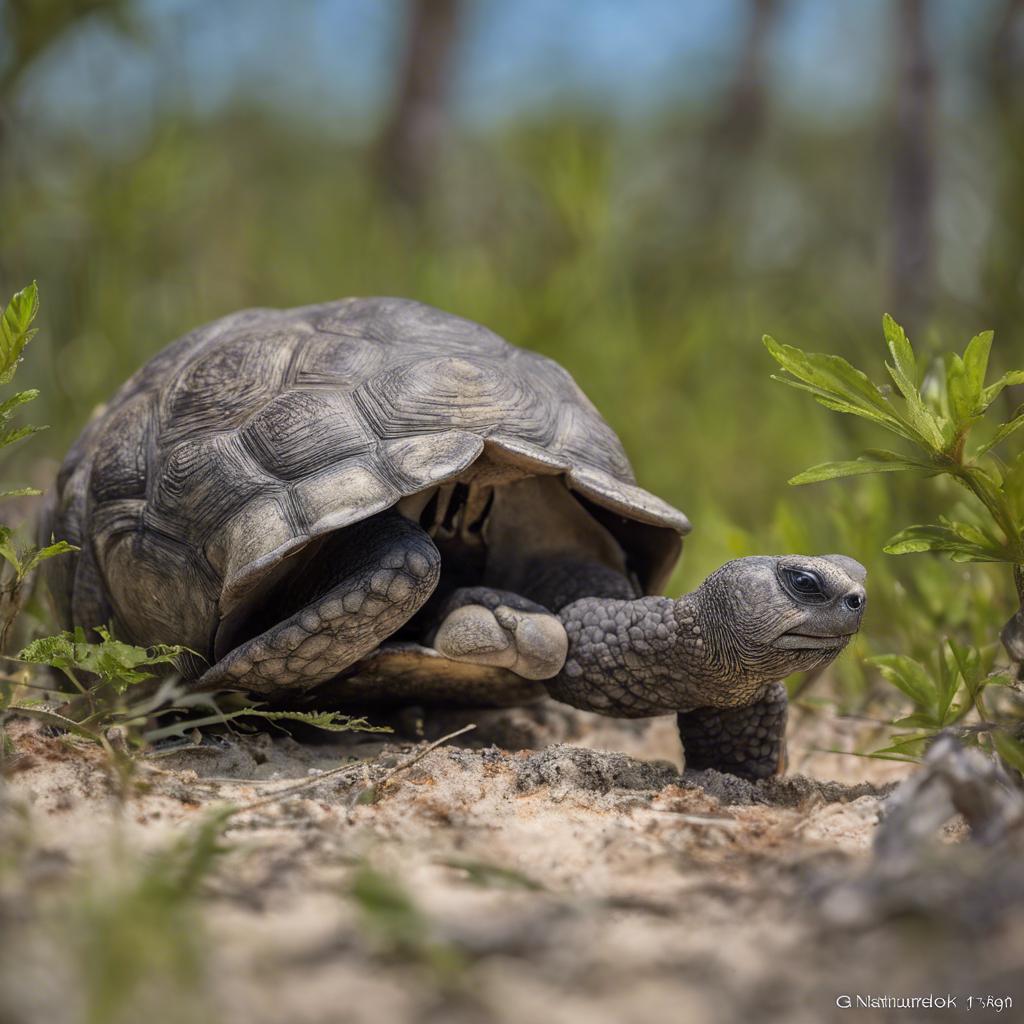Gopher tortoises are a species of tortoise native to the southeastern United States. They are known for their burrowing behavior and are considered a keystone species in their habitat. Gopher tortoises play a crucial role in their ecosystem by creating burrows that provide shelter for a variety of other animals, including snakes, frogs, and small mammals.
Gopher tortoises are primarily found in sandy habitats such as pine forests, scrublands, and coastal dunes. These habitats provide the ideal conditions for the tortoises to dig their burrows and find food. Gopher tortoises are herbivores and feed on a variety of plants, including grasses, legumes, and fruits.
Key Takeaways
- Gopher tortoises are a species of land tortoise found in the southeastern United States.
- Hibernation is a state of inactivity and reduced metabolic activity that some animals enter during the winter months.
- Gopher tortoises do hibernate, but the timing and duration of their hibernation can vary depending on environmental factors.
- Factors that affect gopher tortoise hibernation include temperature, humidity, and food availability.
- Hibernation is important for gopher tortoises because it allows them to conserve energy and survive during periods of low food availability. Conservation efforts are underway to protect gopher tortoise hibernation sites and ensure the survival of this species.
What is Hibernation?
Hibernation is a state of dormancy that some animals enter during the winter months. It is a survival strategy that allows animals to conserve energy when food is scarce and temperatures are low. During hibernation, an animal's metabolic rate slows down significantly, and its body temperature drops.
The purpose of hibernation is to help animals survive through periods of harsh environmental conditions. By reducing their metabolic rate and lowering their body temperature, hibernating animals can conserve energy and survive on stored fat reserves until conditions improve.
Before entering hibernation, animals go through a process called pre-hibernation fattening. During this time, they consume large amounts of food to build up fat reserves that will sustain them throughout the winter. They also find suitable hibernation sites where they can safely spend the winter months.
Do Gopher Tortoises Hibernate?
Contrary to popular belief, gopher tortoises do not hibernate in the same way as other animals. While they do experience periods of reduced activity during the colder months, they do not enter a true state of hibernation.
Gopher tortoises are ectothermic, which means their body temperature is regulated by their environment. During the winter, when temperatures drop, gopher tortoises become less active and spend more time in their burrows. However, they do not experience the same physiological changes that occur during hibernation.
Factors that Affect Gopher Tortoise Hibernation
Several environmental factors can affect gopher tortoise hibernation. The most significant factor is temperature. Gopher tortoises are ectothermic, so their activity levels are directly influenced by ambient temperatures. When temperatures drop below a certain threshold, gopher tortoises become less active and seek shelter in their burrows.
Human activities can also impact gopher tortoise hibernation. Habitat destruction and fragmentation can disrupt the natural burrowing behavior of gopher tortoises and limit their access to suitable hibernation sites. Additionally, disturbances such as construction activities or off-road vehicle use can disrupt the tortoises' natural behavior and cause stress.
The Hibernation Process in Gopher Tortoises
While gopher tortoises do not hibernate in the same way as other animals, they do experience periods of reduced activity during the colder months. As temperatures drop, gopher tortoises become less active and spend more time in their burrows.
Before entering this period of reduced activity, gopher tortoises undergo a process called brumation. Brumation is similar to hibernation but is not as deep or prolonged. During brumation, gopher tortoises slow down their metabolic rate and reduce their activity levels to conserve energy.
Gopher tortoises prepare for brumation by building up fat reserves during the fall months. They consume large amounts of food to store energy that will sustain them through the winter. They also find suitable burrows where they can safely spend the colder months.
Once inside their burrows, gopher tortoises enter a state of reduced activity. They may still move around occasionally to adjust their position or seek warmer areas within the burrow, but their overall activity is significantly reduced. They rely on their stored fat reserves to sustain them until temperatures rise and food becomes more abundant.
How Long Do Gopher Tortoises Hibernate?

The duration of brumation in gopher tortoises can vary depending on environmental conditions. In general, gopher tortoises may enter a period of reduced activity for several weeks to a few months during the colder months.
The length of brumation can be influenced by factors such as temperature, food availability, and the individual tortoise's health and condition. If temperatures remain consistently low and food is scarce, gopher tortoises may prolong their period of reduced activity. Conversely, if temperatures rise and food becomes more abundant, they may emerge from their burrows earlier than usual.
Where Do Gopher Tortoises Hibernate?
Gopher tortoises hibernate in their burrows, which they dig themselves or use abandoned burrows of other animals. These burrows provide the tortoises with protection from extreme temperatures and predators.
Gopher tortoises choose hibernation sites that are well-insulated and provide stable temperatures throughout the winter months. They often select burrows that are deep enough to avoid freezing temperatures but not too deep to prevent access to warmer areas closer to the surface.
How to Identify Hibernating Gopher Tortoises
Identifying hibernating gopher tortoises can be challenging as they are well-hidden inside their burrows. However, there are a few signs that can indicate the presence of a hibernating tortoise.
One sign is the presence of a mound of loose soil or sand near the entrance of a burrow. This mound is created by the tortoise as it digs its burrow and can indicate that a tortoise is inside.
Another sign is the presence of fresh tracks or scat near the burrow entrance. Gopher tortoises may leave these signs as they move around their burrow during periods of warmer weather.
It is important to avoid disturbing hibernating gopher tortoises as they are in a vulnerable state. Disturbing a hibernating tortoise can cause stress and disrupt its natural behavior. If you come across a hibernating tortoise, it is best to observe from a distance and avoid any actions that could disturb the animal.
The Importance of Hibernation for Gopher Tortoises
Hibernation plays a crucial role in the life cycle of gopher tortoises. It allows them to conserve energy during periods of low food availability and extreme temperatures. By reducing their activity levels and slowing down their metabolic rate, gopher tortoises can survive through the winter months on stored fat reserves.
Hibernation also helps gopher tortoises survive in their habitat by providing them with protection from predators and extreme weather conditions. The burrows they create or use for hibernation provide a safe and stable environment where they can wait out the colder months.
Conservation Efforts to Protect Gopher Tortoise Hibernation Sites
Due to habitat loss and fragmentation, gopher tortoises are facing significant threats to their survival. Many of their natural habitats have been destroyed or degraded, making it difficult for them to find suitable hibernation sites.
To protect gopher tortoises and their hibernation sites, various conservation efforts are underway. These efforts include habitat restoration, land acquisition, and the creation of protected areas where gopher tortoises can thrive.
Individuals can also play a role in protecting gopher tortoises by being mindful of their actions and avoiding activities that could disturb or harm the tortoises or their habitat. This includes refraining from off-road vehicle use in sensitive areas, reporting any illegal activities that may impact gopher tortoises, and supporting organizations and initiatives that work towards gopher tortoise conservation.
Gopher tortoises are fascinating creatures that play a vital role in their ecosystem. While they do not hibernate in the same way as other animals, they do experience periods of reduced activity during the colder months. These periods of reduced activity, known as brumation, allow gopher tortoises to conserve energy and survive through the winter months.
Hibernation is an important part of the life cycle of gopher tortoises. It helps them survive in their habitat by allowing them to conserve energy and find protection from predators and extreme weather conditions. Protecting gopher tortoise hibernation sites is crucial for their survival, and individuals can play a role in conservation efforts by being mindful of their actions and supporting initiatives aimed at protecting these unique creatures and their habitat.
If you're interested in learning more about gopher tortoises and their hibernation habits, you might find this article from Reptile Wizard's blog fascinating. It delves into the topic of gopher tortoise hibernation and provides valuable insights into their behavior during the winter months. To read the article, click here: Gopher Tortoise Hibernation: A Closer Look.
FAQs
What is a gopher tortoise?
A gopher tortoise is a species of tortoise native to the southeastern United States. They are known for their burrowing behavior and are considered a keystone species in their ecosystem.
Do gopher tortoises hibernate?
Yes, gopher tortoises do hibernate. They typically hibernate during the winter months when temperatures drop below 60 degrees Fahrenheit.
Where do gopher tortoises hibernate?
Gopher tortoises hibernate in their burrows, which they dig themselves. These burrows can be up to 40 feet long and 10 feet deep.
How long do gopher tortoises hibernate?
Gopher tortoises can hibernate for several months, depending on the temperature and availability of food and water. In some cases, they may hibernate for up to six months.
What do gopher tortoises eat?
Gopher tortoises are herbivores and primarily eat grasses, legumes, and other vegetation. They also eat fruits and flowers when they are available.
Are gopher tortoises endangered?
Yes, gopher tortoises are considered a threatened species in the United States. Their populations have declined due to habitat loss and fragmentation, disease, and predation.

